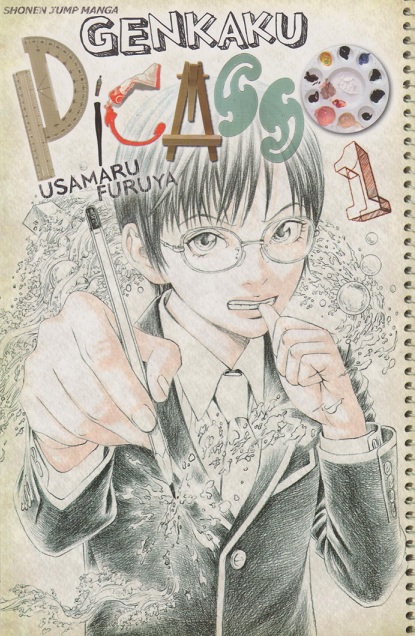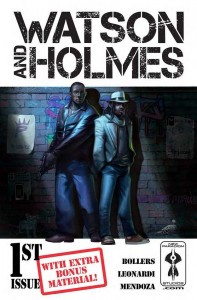 Title: Genkaku Picasso
Title: Genkaku Picasso
Author: Usamaru Furuya
Publisher: Viz Media (Shonen Jump)
Volume: Volume 1 (of 3), $9.99
Vintage: 2008 by Shueisha in Japan, November 2010 by Viz Media
Genre: Drama, art, psychological
What would you do if your only chance to keep living was to help others? That’s the position our main character, Hikari “Picasso” Hamura, finds himself in. When a helicopter crashes near the river where Hikari and his friend Chiaki are drawing and reading (respectively), they are both killed. But as she was dying, Chiaki prayed that Hikari would survive so that his talent could be viewed by the world. However, in exchange for returning him to life, Hikari must continually help others or risk literally rotting away. Chiaki has come back in the form of a pint-sized angel to help him. In order to help others, he has been given the ability to view the auras of those in need, which he transfers to drawings in his sketchbook. At the crisis turning point, Hikari’s consciousness and Chiaki go into the drawing and attempt to solve the problems in the individual’s mind and heart. If they succeed, the person grows and overcomes their inner struggle, and Hikari and Chiaki are returned to the regular world, minus rotting limbs.
Volume 1 introduces us to Hikari and Chiaki, as well as several of their classmates, two of whom quickly become the secondary characters of the story. Frequently interacting with Hikari after the high school boy saves them both from their troubles are Sugiura (who has been having trouble talking to his father) and Akane (a model traumatized by a childhood memory). Sugiura is a nice guy who is grateful for Hikari’s help, but while helping Akane, Hikari somehow transplanted the image of himself into her mind as a comfort and emotional support. To Suguira’s chagrin (as he has a crush on her), Akane becomes inexplicably attached to Hikari. Having made two new friends, after previously only being friends with the now deceased Chiaki, Hikari’s life gets more lively and the awkward, introverted boy is forced to interact with others. Unfortunately, Hikari is just annoyed that no one leaves him alone anymore, and Chiaki is constantly nagging him to help the next person, leaving him little time to himself to practice his drawing. But Chiaki is there to not only help keep him alive, but to introduce him to a world of experiences that he previously ignored. There’s a little humor here and there as Hikari’s horrible social skills create some awkward situations.
This one has an interesting concept, but is a little boring. I know that doesn’t make a lot of sense; perhaps it’s the execution. The story just doesn’t ring with me, but it was an interesting read. My only real complaint is the art. The sketches that Hikari draws are amazing, and with that kind of talent, I wonder why the entire rest of the book looks a little sloppy. It just doesn’t have the same quality. Not that it should be exactly the same; that kind of detail takes far too long to draw, and it would also defeat the feeling of Hikari and Chiaki being sucked into another world. Still, it’s like a completely different person draws each part. My other complaint is about Viz’s production of the book. It’s the font choice. It’s bland, and there’s a lot of empty, white space. Really it’s just a small, personal annoyance that most people probably wouldn’t be bothered by. While reading this one, I wondered how long it could really be dragged out, as each situation, while different fundamentally, starts and resolves much the same way. At three volumes, it should end up just right.
Kris
kristin@comicattack.net
girlg33k_Kris
Review copy provided by Viz Media.



I actually really liked this book, but I think it’s more a parody of those sorts of episodic paranormal investigator series. One of the strongest indicators is the surprising depth of magic pixie dream girl/cheerleader Chiaki and the way she cuts right to the heart of the ‘hero’s’ flaws and intentions in a way that no other shonen MC needs to account for. Honestly, I don’t really see any difference between the hero here and the guy in XXXholic except this one actually gets called on his BS.
I’m thinking the art imbalance you mentioned is…well, half-intentional. The way most of the book is drawn is the artist’s natural style, but the dream sequences are that much more detailed and artistic because they’re an extension of McGlasses’ art. Because McGlasses views the world of his art as that much more vivid and real than the real world, they end up a lot more detailed. If you think the regular art is bad, I can’t account for that though, haha.
Ultimately, I totally agree with you that I wouldn’t be able to get much mileage out of this title though. The hero…Hikari, is just so acerbic and shows zero signs of any real development, it’s like the problem I mentioned before with The World Ends with You except the grey-haired kid was the MC and prolly won’t get any more tolerable. For me, the laughs made up for it, but there’s only so long I can tolerate Hikari’s attitude. It’s the same reason I ended up dropping XXXholic and that’s a really beautiful book.
It was kind of funny. I laughed a couple times (Hikari’s awful social skills lead to some amusing dialog). But it didn’t really stick with me. I’m sure it will resonate better with others, because it’s not a bad title, it was just a little dull to me.
Pingback: Recent and future reading « MangaBlog
Pingback: Tweets that mention Bento Bako Lite: Genkaku Picasso vol. 1 -- Topsy.com
Pingback: Bento Bako Weekly: Genkaku Picasso vol 2
Pingback: Usamaru Furuya Manga Moveable Feast: Archive — Experiments in Manga